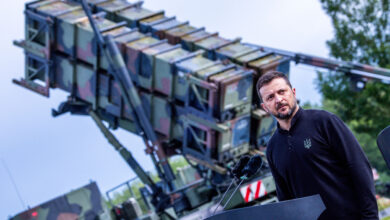Raytheon has been awarded a $315 million contract for Griffin mini-missile production, improvement and support, a U.S. Department of Defense release said.
Additional funding will be obligated on a delivery/task order basis to the sole-source acquisition indefinite-delivery/indefinite-quantity contract for AGM-176 Griffin missiles, the Friday, June 29 release said.
U.S. Special Operations Command is the contracting activity.
The release noted a request for information was posted to the Federal Business Opportunities website on February 26, and only Raytheon provided a response. The intent to sole-source was posted from March 9.
Jane’s reported in February that the RFI was for a powered stand-off precision-guided munition to be carried by AC-130W Dragon Spear/Stinger II and AC-130J Ghostrider gunships, allied-operated Cessna AC-208 Combat Caravans, and other manned and unmanned aircraft. The RFI called for a 50 lb-class munition that is lethal against static and manoeuvring people and non-armored vehicles, more than hinting at the Griffin.
The AC-208, the attack variant of the Cessna C-208B Grand Caravan, is increasingly used in counter-insurgency operations around the world, notably in Iraq and Afghanistan.
On the intent to sole-source notice, Jane’s reported that SOCOM’s pre-solicitation covered the purchase of up to 800 Griffin missiles by 2021, with 640 more expected to be purchased in the same period. It also said a potential 1,440 missiles could be procured in 2022, for a total of 2,880.
In January, Raytheon was awarded a $105 million contract for Griffin missile production by the U.S. Air Force.

Griffin: a light, flexible missile for land, sea and air
Raytheon’s AGM-176 Griffin mini-missile is 43 inches (109cm) long, and weighs 34 pounds (15.4kg) and comes in two variants, with two others in development. It uses GPS-aided inertial guidance and a semi-active laser seeker to deliver its relatively small 13-pound (5.9kg) warhead, which is intended to reduce collateral damage.
The missile’s estimated range – around 3.5 miles (5.6km) for ground launch, or 12.5 miles (20km) for air launch – is similar to the AGM-114 Hellfire missile, but its smaller size means three Griffins can be carried in place of one Hellfire, albeit with smaller warheads.

Griffin A is an aft-eject munition that can be deployed from platforms like C-130 aircraft, including the KC-130 tanker, the AC-130 gunship and the MC-130 special mission aircraft, for which it was originally designed. It can be dropped from a 10-tube launcher from the rear cargo ramp, or from a door-mounted launcher, allowing the missile to be deployed while the aircraft’s cabin is pressurized.
The forward-firing Griffin B can be launched from rotary and fixed-wing manned and unmanned aircraft, including the MQ-9 Reaper and MQ-8B Fire Scout drones, the V-22 Osprey tilt-rotor aircraft and OH-58D Kiowa Warrior helicopter, and the A-29 Super Tucano light attack aircraft, as well as C-130 variants. It is also operational on U.S. Navy’s Cyclone-class coastal patrol vessels
The under-development Griffin C may be an attempt to compete with the Hellfire and MBDA’s Brimstone 2 missile. It adds a dual-mode semi-active laser and imaging infrared seeker, and a datalink that can redirect the missile to a new target in flight, making a fire-and-forget missile system. Griffin C-ER is, as the name suggests, and extended range variant.












